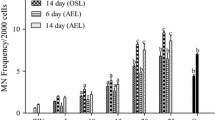Abstract
The Tradescantia micronucleus assay has been used since 50 years for the detection of genotoxins (including carcinogens) in the environment. A large database concerning the effects of individual chemicals and complex environmental mixtures (soil, air and waters) has accumulated. In contrast to other mutagenicity test systems, the effects of low concentrations of heavy metals, radionuclides, certain herbicides, pesticides and gaseous mutagens can be detected and it is also possible to conduct in situ biomonitoring studies with plant. The test system has been validated and standardized protocols have been developed for laboratory experiments and for field studies which are described in this chapter.
Access this chapter
Tax calculation will be finalised at checkout
Purchases are for personal use only
Similar content being viewed by others
References
Majer BJ, Grummt T, Uhl M et al (2005) Use of plant bioassays for the detection of genotoxins in the aquatic environment. Acta Hydrochim Hydrobiol 33:45–55
Leme DM, Marin-Morales MA (2009) Allium cepa test in environmental monitoring: a review on its application. Mutat Res 682(1):71–81
Foltete AS, Dhyevre A, Ferard JF et al (2011) Improvement of Vicia-micronucleus test for assessment of soil quality: a proposal for international standardization. Chemosphere 85(10):1624–1629
White PA, Claxton LD (2004) Mutagens in contaminated soil: a review. Mutat Res 567(2–3):227–345
Steffensen D (1953) Induction of chromosome breakage at meiosis by a magnesium deficiency in Tradescantia. Proc Natl Acad Sci U S A 39(7):613–620
Ma TH, Cabrera GL, Chen R et al (1994) Tradescantia micronucleus bioassay. Mutat Res 310(2):221–230
Suyama F, Guimaraes ET, Lobo DJ et al (2002) Pollen mother cells of Tradescantia clone 4430 and Tradescantia pallida var. purpurea are equally sensitive to the clastogenic effects of X-rays. Braz J Med Biol Res 35(1):127–129.
Batalha JRF, Guimaraes ET, Lobo DJA et al (1999) Exploring the clastogenic effects of air pollutants in Sao Paulo (Brazil) using the Tradescantia micronuclei assay. Mutat Res 426(2):229–232
Ohe T, Watanabe T, Wakabayashi K (2004) Mutagens in surface waters: a review. Mutat Res 567(2–3):109–149
Stahl RG Jr (1991) The genetic toxicology of organic compounds in natural waters and wastewaters. Ecotoxicol Environ Saf 22(1):94–125
Ma TH (2001) Tradescantia-micronucleus bioassay for detection of carcinogens. Folia Histochem Cytobiol 39(Suppl 2):54–55
Ma TH, Cabrera GL, Owens E (2005) Genotoxic agents detected by plant bioassays. Rev Environ Health 20(1):1–13
Ma TH, Harris MM, Anderson VA et al (1984) Tradescantia-micronucleus (Trad-MCN) tests on 140 health-related agents. Mutat Res 138(2–3):157–167
Rodrigues GS, Ma TH, Pimentel D et al (1997) Tradescantia bioassays as monitoring systems for environmental mutagenesis: a review. CRC Crit Rev Plant Sci 16(4):325–359
Mišík M, Ma TH, Nersesyan A et al (2011) Micronucleus assays with Tradescantia pollen tetrads: an update. Mutagenesis 26(1):215–221.
Klumpp A, Ansel W, Fomin A et al (2004) Influence of climatic conditions on the mutations in pollen mother cells of Tradescantia clone 4430 and implications for the Trad-MCN bioassay protocol. Hereditas 141(2):142–148
Misik M, Krupitza G, Misikova K et al (2016) The Tradescantia micronucleus assay is a highly sensitive tool for the detection of low levels of radioactivity in environmental samples. Environ Pollut 219:1044–1048
Tolbert PE, Shy CM, Allen JW (1991) Micronuclei and other nuclear anomalies in buccal smears: a field test in snuff users. Am J Epidemiol 134(8):840–850
Acknowledgments
We thank P. Breit and E. Gottmann for help in the preparation of the photographic images.
Author information
Authors and Affiliations
Corresponding author
Editor information
Editors and Affiliations
Rights and permissions
Copyright information
© 2019 Springer Science+Business Media, LLC, part of Springer Nature
About this protocol
Cite this protocol
Mišík, M., Pichler, C., Rainer, B., Nersesyan, A., Mišíková, K., Knasmueller, S. (2019). Micronucleus Assay with Tetrad Cells of Tradescantia. In: Dhawan, A., Bajpayee, M. (eds) Genotoxicity Assessment. Methods in Molecular Biology, vol 2031. Humana, New York, NY. https://doi.org/10.1007/978-1-4939-9646-9_18
Download citation
DOI: https://doi.org/10.1007/978-1-4939-9646-9_18
Published:
Publisher Name: Humana, New York, NY
Print ISBN: 978-1-4939-9645-2
Online ISBN: 978-1-4939-9646-9
eBook Packages: Springer Protocols




